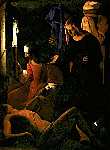We are at the start of our visit through the Louvre. Many of the artists presented in the world's most
prestigious museums emerged from their own private hell before being granted access to them, but it
is sheer oblivion that preceded Georges de La Tour's arrival there.
Since the end of the XVIIth century and throughout the entire XVIIIth and XIXth centuries, this artist
was totally forgotten. During that time, his works were attributed to all and any. In the museums
fortunate to own them, the labels indiscriminately read Guido Reni, Saraceni, Gentileschi in those
near to Italy; Terbrugghen or Honthorst in those near the north; and Zurbaren or Velasquez
in those near the south. In other words, in art history his oeuvre
was spread out all over the place: truly, an extraordinary example of total exile.
|

To see the diversity of these first paintings is to understand how easily they could be compared,
confused, or linked to other specific artists, in the style of the raw realism of the Flemish school
or the muted light of Caravaggio. |

|

Before broaching the works themselves, a short look at the historical context
in which Georges de La Tour's career was anchored might shed a welcome light.
|

|
If you have time for a short visit only, or if for the moment your interest is limited to a specific painting, this page can provide guidance:
Works Index - Program Plan



